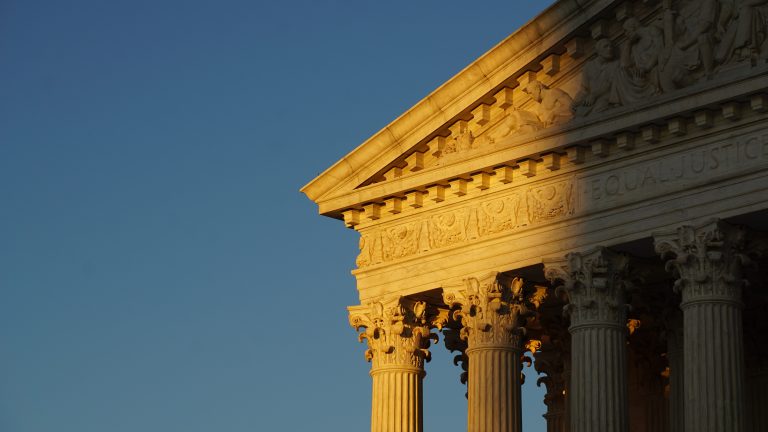Gun-rights advocates may want to hold off on uncorking their champagne bottles in response to the Supreme Court’s decision to take up their first-ever gun-carry case.
The outcome of the case against New York’s restrictive concealed carry permit regime is far from certain, according to legal experts who spoke to The Reload. While gun-rights groups have cheered the Court and gun-control groups derided it for taking the case, experts said the Court is hard to predict and there are numerous realistic outcomes gun advocates may not like. The experts said the Court’s ideological makeup does not guarantee a particular ruling.
“Gun-rights advocates should not count their chickens yet,” Robert Leider, assistant professor at George Mason University’s Antonin Scalia Law School, told The Reload. “Challengers will need five of the six conservatives to win. There are several ways this case could go against the challengers.”
The outcome of the Court’s first gun-carry case will have broad implications for the future of gun laws in America, whatever that outcome ends up being. New York’s restrictive concealed carry permit application process, which allows government officials to deny permits even if an applicant passes the required background check and training, is in place in seven other states. Together with New York, those states house more than 25 percent of the nation’s population.
If the court strikes down New York’s law, it will likely create a cascade effect that wipes the other states’ laws from the books as well. The subjective judgment of state officials would be removed from the process, and the states would be required to issue permits to anyone who qualified for one. The Court could go even further and strike down any permitting requirement at all for law-abiding Americans who want to carry a concealed firearm.
But Josh Blackman, a South Texas College of Law professor and Cato Institute scholar, said those are far from the only possibilities.
“They might try and duck the issue or find some way to avoid ruling on it or make some really narrow ruling that only affects New York and let them modify their law to get around it,” he told The Reload. “For all we know, the Court could say, ‘Yes, the Second Amendment applies outside the home. Remand and consider whether New York’s regime is consistent with the Second Amendment.’ And then we know nothing.”
He pointed to the Court’s two-page ruling in 2016’s Caetano v. Massachusetts as an example of how the case could end up shedding no additional light on the Second Amendment. In that case, the Court told the Massachusetts Supreme Court stun guns were protected under the Second Amendment because 2008’s landmark Heller decision already established modern weapons were protected. But the court did not expound any further on the amendment or what standard lower courts should use to examine Second Amendment cases.
Jake Charles, executive director of Duke University’s Center for Firearms Law, said the Court taking a case usually indicates they want to overturn the lower court’s decision. In this case, the 2nd Circuit upheld New York’s permitting process, but Charles said that might not be as strong an indicator the Court wants to establish Second Amendment protections extend to concealed gun carry. He said it isn’t an “open-and-shut” kind of case.
“Since we haven’t got a lot of guidance on the Second Amendment, they might want to provide guidance,” Charles said. “We might get some judges looking to the history and coming to one outcome. We might get some judges who are applying tiers of scrutiny, intermediate scrutiny or strict scrutiny, and coming to different conclusions.”
Still, Charles said the Court moving straight to a gun case on one of the key outstanding Second Amendment issues instead of taking a case with lower stakes shouldn’t be overlooked.
“That’s significant itself,” he said. “It tells those of us that are court watchers and Second Amendment watchers that the court wants to want to settle some of the big questions that are outstanding here.”
He noted the case was discussed by the justices three times in conference before being granted.
“I suspect that there was something hammered out of ‘alright, we have five justices who agree on something,'” Charles said. “Either the result in this case or the methodology for future Second Amendment cases. I have to think that there’s going to be a majority on at least one of those questions.”
Blackman said after four justices vote to take a case, what remains is to “haggle over” the question to be answered. The Court decided to limit the case to whether New York violated the plaintiffs’ Second Amendment rights by denying them a concealed carry permit instead of keeping the broader question of whether the Second Amendment generally protects the ability to carry a gun in public for self-defense. Blackman said the Court’s decision to rewrite the question was a bad sign for an expansive opinion from the Court.
“My optimism for a broad ruling lasted a grand total of 30 seconds until I saw that they granted a revised question,” he said. “Why did they do that?”
Leider said the framing could “fracture the conservative/originalist wing” over disagreements about whether Second Amendment protections extend not just to gun carry but specifically concealed carry. He said some of the conservative justices could follow in the recent footsteps of Ninth Circuit Judge Jay Bybee, a George W. Bush appointee, and find the historical record doesn’t support a general right for individuals to carry guns in public for self-defense. He said it was an open question how some of the more moderate conservatives on the Court could vote.
“Chief Justice John Roberts and Justice Brett Kavanaugh are more moderate, and there have been rumors that the Chief Justice blocked the conservatives from deciding this issue earlier with a threat that he would vote to uphold the restrictions on public carry,” Leider said. “Justice Samuel Alito is a former prosecutor from New Jersey, which has very strict gun control laws. Justice Alito’s background probably makes him sympathetic to strict gun control. Although Justice Alito voted to recognize a Second Amendment right to have a handgun in the home, it is quite possible that he will not want to vote to recognize a right to carry a concealed weapon in public.”
Charles said he foresees a clash between the conservative justices over how to even review the question in the case.
“We’ve seen Justice Kavanaugh advocating for the text, history, and tradition approach,” he said. “It’s not entirely clear that all of the conservative justices would be into a historical test like that. Justice Alito strikes me as one who maybe wouldn’t be all in on a test based on history.”
Blackman said it is possible the question change is not as significant as it appears at first glance.
“I can’t imagine Kavanaugh and Barrett flinch on this one, but maybe Roberts is trying to pull some stuff hoping he can make this action limited,” Blackman said. “Maybe none of this matters. Maybe, ultimately, this was just the liberals trying to throw a wrench in things, and then the conservatives will do whatever they want. That’s entirely possible.”
But he isn’t optimistic.
“I’ll believe it when I see it,” he said.






